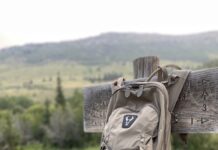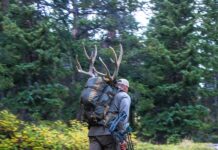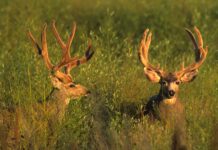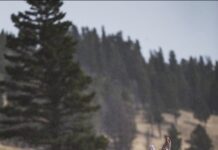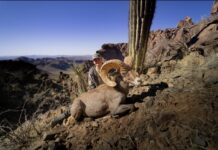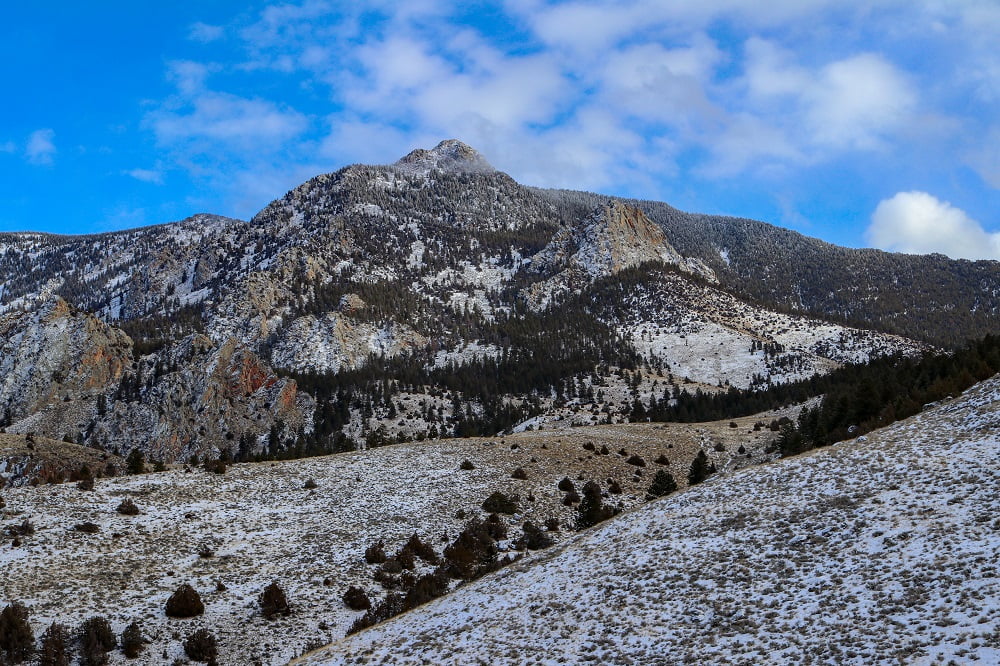
I have worked the past 10 years as a professional scout for WeScout4u.com. The company was founded by Robby Denning in 1997 and has served hundreds of hunters throughout the West. It’s been an exciting and educational experience for me, so I thought I would share a little about what I have learned over the years. This article could help you become a more successful hunter.
Scouting a new unit/area
Scouting has changed significantly over the past 10 years or so due to all the new technology, giving you the ability to learn a lot about an area from your own home via e-scouting. A couple of the game changers were Google Earth (GE) and onX Hunt. Now there are a whole slew of apps out there that you can put in the palm of your hand that can eliminate tons of groundwork.
Of all the technology out there the one that changed it the most for me is GE. When going to a new area I used to have to make my best guess by looking at a map of what country would look like. I actually got pretty good at this. Of course, doing this you never knew what to expect for sure; sometimes I’d hike for hours to a spot just find out it wasn’t glassable and or not the right habitat. GE has streamlined my destinations and routes to an area. It hasn’t taken the place of a paper map for me, but if anything has helped improve my map reading skills. They work well hand in hand with each other.
All these new tools are great but in no way shape or form has taken the place of boots on the ground. To rely only on technology can lead to a big fat nothing. Even GE can be deceitful; you may think you are going to have awesome glassing only to find out it is completely the opposite–been there many times. Bottom Line these are very helpful tools.
Phase 1
Before I go to a new area that I’m not overly familiar with, I want to become familiar with the area by going over maps including Forest Service & Motorized Travel plan maps and GE. I prefer paper maps to electronic maps as I can open it up and look over the whole area at once and get a good picture on the unit very quickly. I tend to gravitate to the roadless/trailless areas. Sometimes mapping systems such as onX Hunt can be very helpful as well, especially if there is lots of mixed ownership.
After I have familiarized myself with the area, I like to talk to a biologist, game wardens, taxidermists, or anyone that might give me a head start on the area. Timing for a scouting trip can be huge in learning a new area often times late June early July are overlooked. I find this time to be very effective for scouting new country as often times the animals are where they will be during the summer and much more visible and quicker to locate against the oftentimes green backdrop. The weather is often times cooler than in late July/August and it often seems like they spend a lot more time feeding consistently on the new growth, catching up on their depleted stores as opposed to later in the summer.
I’ve found some awesome areas this time of the summer and by far and away see the highest numbers of bucks and bulls. Antler growth is along far enough to get a good idea on the potential for a buck or bull. In fact some of the best bucks I’ve ever seen were found this time of the year. I’ve gone back later in August knowing where to find them. Some of them were so hard to spot in August that if I didn’t know they were there I may have never found them.
Also, fires tend to be more prevalent later in the summer which can absolutely wreak havoc on a scouting trip by severely limiting visibility; as was the case in 2018 in a lot of areas. Of course some high country is not open early summer so that will dictate when you can scout.
I like to call the Forest Service to check roads and snow conditions prior to deciding on a day to head in. Also the SNOTEL website gives good information by providing snow depths in a lot of areas but if going to the real high country, you might want to look at the elevation of the station in relation to the elevation you plan on going. At these high elevations, year-to-year can be drastically different so I try to pick my way through the local Forest Service office looking for someone who has been recently to where I want to go.
If going later in the summer and flexible on when you can go, I’d watch the weather and pick the coolest days to go as this can have a huge effect on spotting animals. After processing all of this I will then come up with a plan of attack.
Phase 2
My first goal when I set foot in the area is to cover as much country during the day, and be in the best places to glass both morning and evening. While covering ground during the day, I’m looking for sign such as tracks, beds, water sources, wallows, rubs, game trails, or any other useful information.
This all can be very important information and often times I have found my best area’s during this time. Once I glassed an area that had a lot of broken country with pockets of brush, timber, and aspens and just looked like a great spot I spent the whole morning glassing it and didn’t but see even two deer. I was disappointed and probably would never have looked back there again had I not decided to walk down a ridge and back up another ridge before leaving the area. While doing this, I noticed the place was loaded with both deer and elk tracks; I ended up checking it out again a couple of weeks later on a cooler day and saw loads of deer and elk. It has become a go-to spot to take kids hunting as it is a sure bet.
I also spend time checking roads and all access points. It sucks when you find a good spot only to find out during the season that there is an alternate motorized route into the area; or even worse you find a great spot from afar and see a way to get there on a map only to find out during the season you can’t make it up the road or trail.
I’m also taking note of possible winter range sign like old droppings that seem to be very old. Often times you can see trails leading out of the high country showing a migration route as your season might be later in the fall and you can get to a place where you have seen a lot of animals only to find they have migrated.

I’m also taking note of the greenest feed, water sources that might dry up, or water sources that look like they would survive in a dry year. This knowledge can help you in a dry year where the game isn’t in places they had been previously as they may be more congregated in these areas.
One of the most important things I’m doing during the day is identifying what I want to glass and where I want to glass from at prime times. If you only get a couple of days to scout, you want to spend your prime time glassing efficiently not wasting time looking for glassing spots, or even glassing mid-day when it’s hot and game isn’t moving much.

Also, part of identifying places to glass from is to pick so that the sun is at your back for the majority of your glassing. However, keep in mind that at very first light or last light, before or after the glare causes any issues, can be good even glassing into the sun. I like to glass the country into the sun’s direction first in the morning as it will become near impossible to see once it does become an issue and the animals seem to be moving a bit earlier to get ahead of it. This initial scouting trip is spent glassing as much different country as I can possibly do efficiently as long as I don’t waste much time traveling between spots such as a ridgeline that is at the head multiple drainages, allowing me to look high to low and being able to quickly get to the next drainage.

Depending on the country, I prefer to glass more for volume than to pick apart terrain and cover, unless there is just an obvious spot that I know holds game. Sometimes, depending on the country, glassing from a road looking far away and getting quickly to the next spot is very effective on locating what country holds game. If I do this, it seems more effective in the evening where the game seems to be coming out of their bedding areas to expose themselves in pretty visible areas. It also seems to be a shorter window than in the morning.
I have often found that in the evening on a hot day, the game tends to come out on the east facing basins and slopes first. Ideally, I will be on a ridge with the sun at my back glassing these; however if you are low, it can be hard to look up, but once the sun goes out of sight on the west side, it allows you to look up these slopes then move quickly to glass the west-facing slopes where if they come out, it will be the last few minutes . Sometimes being able to move from spot-to-spot quickly in this way can yield some impressive game numbers the last 30 minutes or so of light.
One thing that has helped me learn areas better over the years is to talk to people in the unit. Usually this time of the year they are locals or from close by. Sometimes they will throw a name out or give you some insight on the area that might pan out.
Also, take note if you see someone glassing a particular country as this can be a tell. Once I was in a big unit that I knew very well. There was a part of the unit that did not seem very habitable for game and you would never see people hunting it, so I never took the time to check it out. One day, I noticed two guys intently glassing a certain habitat in this country. I just looked where they were looking and sure enough, there was a bachelor group of bulls. I spent the rest of the evening glassing the area and ended up seeing over 200 elk. It ended up becoming a very good spot for me over the years. My main goal in this phase is to locate the country these animals use and get to know the area as a whole.
Phase 3
My next step is to evaluate all this information. Seldom is it exactly like I thought when I did all my e-scouting and pre-scouting. At this point, when I look at GE and maps, I will be far more effective as I will have a better idea what I’m looking at as far as vegetation the habitat the game was using and so on. I will be able to eliminate a lot of country and narrow down the country I want to look at the next time I scout it, or a better way to get to spots that I liked. Also, by looking at the access, roads, old hunting camps, etc., you can get a feel where the pressure is going to be. You might find an area stacked with elk but it’s right off a road. A lot of people will hunt the area so I’m not going to waste too much time because when the season rolls around odds are, the elk aren’t going to be there. When I find spots like these I also try to note where the natural escape routes are going to be.
Now after you physically scouted the unit, info you gather from home will have a lot more meaning; like talking to a biologist you can ask more specific questions, sometimes they seem to open up a little more when you talk like you know the unit rather asking the same general questions 90% of the hunters ask. I have found this step to be very important as when I am in scouting mode, I often overlook things. When I can sit back and take it all in, things become a lot clearer. I like to do this as soon as I can after scouting when it’s all fresh in my mind, often when I get back to the truck after scouting all day. I always do this step after every scouting trip regardless of how well I know the area, always looking for new angles.
Phase 4
My next scouting trip, I will be more deliberate on where I’m glassing at prime time although it may be necessary to do more of the initial scouting to better familiarize yourself with the area before narrowing. I still spend my days doing the same type of intel, just a bit more narrowed down.
When I glass in the prime time, I’m usually going for a particular spot and glassing the country I believe is the right habitat types which I identified on my first scouting trip. For the most part, I’m still looking for easier animals and not picking the country apart with a fine-tooth comb unless that’s what it requires to glass effectively, such as a burn. I still would like to look at as much of the “right country” as I can.
I still like to find spots to glass from where I can easily look at new country without moving very far, like from a peak that has several basins on it that I can quickly move just a little and glass new country. At this point I’m still learning the unit and want to learn it in steps. I don’t want to get tunnel vision and overlook awesome country. My goal also is to find what they are eating, where they are bedding, and their tendencies. Once I narrow down the best areas, that’s when I will pick it apart. It’s one thing to spend hours picking apart a drainage you hope there are animals in, but a whole different thing in knowing you are looking at an area that holds animals, Confidence is extremely important while glassing. Without it, it’s hard to glass effectively. I know if I start second guessing what I’m looking at, it’s harder for me to have the patience to pick it apart to the level that it requires to find the next-level animals.
Phase 5
When I get to the point where I know exactly where I want to look, I predetermine the places I want to glass from. I am on a mission to get to that spot before glassing light or if I’m in a place in the evening, wait till I can’t see anymore before leaving. A lot can go on the first and last 30 minutes of light. It’s a bad feeling when you’re still hiking to your glassing spot up a timbered ridge and it’s getting light knowing the big buck you’re looking for might already be making his way to bed.
When I start glassing I’ll give all the likely country a quick scan, then spend most of my time slowing down and looking hard at those high percentage areas that I determined from the initial trips. Every once in a while, I’ll give the bulk of country a quick glass especially when the sun first hits new country as they seem to light up this time of the year.
There are some mornings when they do not even come out and this is why it is so important to have confidence in an area before you invest the time to really scout it hard. I’ve had times where I’ve seen 25-30 bucks from one spot only to come back a couple of weeks later and not see one deer in the open; the only ones I found were bedded. This is my favorite Phase to scout where I can pick the country apart finding those next-level animals; often times I’m using tripod-mounted binoculars and a spotting scope with confidence that I’m in the best spot possible to find what I’m looking for.

Every unit has a formula to finding game. The more I scout a unit, the more I understand the critters in that unit. Some places are a lot harder to crack than other’s and may take a lot more scouting to figure out, but I can tell you it is well worth it when hunting and you know where your quarry is and how to find it opposed as to wandering the mountains for a week hoping you are looking in the right area.
It’s possible to do these 5 Phases in one trip, especially if you have several days. If nothing else, get to the area a few days before your season and do the steps because once you’re hunting, you need to be in your best spot in phase 5 mode. If you don’t do all the steps, including the evaluating step, you may not be doing the unit justice.
I’ve known my fair share of guys who have hunted an area from one camp for years with good success yet didn’t know the unit very well overall. When something changed, like weather or wolves or hunting pressure, they gave up on it or are the people complaining that area is ruined, when often times I know there are even better spots not too far away but once you get tunnel vision on an area it can be hard to deviate.
Scouting Open Season
Probably one of the most overlooked times to really learn a unit that you plan on hunting again is during the season after you fill your tag. I find that a lot of hunters go into relax mode. But this is a perfect time to get to know the unit better without the pressure of having to be in the perfect spot. It will let you know where the hunting pressure is and finding where the game is during the season. I like to approach it like I’m hunting although I tend to check areas that have potential but are more of a question to me. This has allowed me to eliminate areas or even find honey holes.
For instance, I shot a bull with my bow very early in the season one year. This was in a spot that I had luck in the prior few years and thought was as good as it gets. I spent most of the rest of archery season with no tag “hunting” different spots in the zone that I had never been in during the bugle. In that period of time, I had many encounters with big bulls and maybe the most enjoyable time “hunting” I’ve ever had–funny how easy it is when you don’t have that pressure. Interestingly enough, that area I had taken the bull in didn’t even make the short list for future hunts after taking in this new recon. Even just driving around looking at camps meat poles and talking to other successful hunters can be very telling.
Case Studies

I shot this muley buck in an area I was unfamiliar with. It was a large area with low deer numbers and lots of different country. I had a few days off and picked up a tag just days before the season. I followed the steps above and found an area I wanted to pick apart during prime time. On the last afternoon before the season ended, I found him at last light and shot him the next morning.

I shot this antelope this past season. It was like the muley scenario, although I was able to scout for a couple of days during the summer. I knew because of time constraints, I would only be able to hunt for one day if I was lucky. I covered nearly the entire unit looking for the spot s I wanted to focus on. I found that there were a couple of hot spots, but they were not where the biologist had told me in the huge area. It was also very dry and I located the best water holes around the hot spots. I counted 114 bucks the one day I had to hunt and shot this one late afternoon; most of the bucks were close to the water. Traveling from one area to the other, I had quite a few guys ask if I had seen much, they all seemed to have a lousy time and blamed it on the 90-degree temps!
You can comment on this article or ask Jim questions here.




